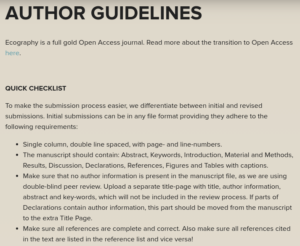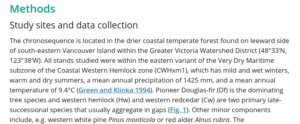Source of Scientific Information:
Lu, P., Parker, W. H., Cherry, M., Colombo, S., Parker, W. C., Man, R., & Roubal, N. (2014). Survival and growth patterns of white spruce (picea glauca [Moench] Voss) rangewide provenances and their implications for climate change adaptation. Ecology and Evolution, 4(12), 2360-2374. https://doi.org/10.1002/ece3.1100
Quality of Information:
Academic, peer-reviewed research material.
Rationale:
- This paper is “academic material” because it is written by several ecology experts, includes in-text citations, and has a references list.
- This paper is “peer-reviewed’ because it explicitly said that was reviewed in the Acknowledgements section and because it can currently be found on PMC, which only uploads publications from journals after they have been peer reviewed (Disclaim, 2020).
- This paper is considered “research material” because the authors conducted field research and a statistical analysis that is reflected in their Methods and Results sections
Reference:
Disclaimer. (2020). National Center for Biotechnology Information. https://www.ncbi.nlm.nih.gov/pmc/about/disclaimer/





